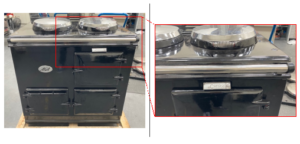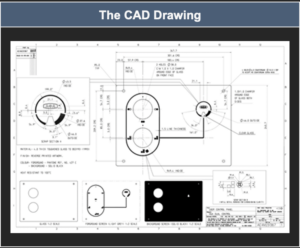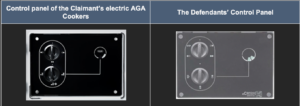In AGA Rangemaster v UK Innovations ([2024] EWHC 1727 (IPEC)), the UK Intellectual Property Enterprise Court has held that AGA’s trade marks were infringed by a company selling refurbished AGA cookers in a certain manner. AGA also relied on copyright in a design drawing of an AGA control panel and claimed copyright infringement by the Defendants’ control panel. However, the court found that the Defendants were entitled to rely on the defence afforded under section 51 of the Copyright, Designs and Patents Act 1988. This was on the basis that the control panel itself could not be considered an “artistic work”.
The decision has been granted permission to appeal to the Court of Appeal. That means we finally might have clarity in the UK on whether a work that is a 3D work, has to be an ‘artistic work’ in order for copyright to be enforced; in other words: does the Cofemelapproach apply in the UK or not?
The background
The Claimant (“AGA”) make and sell AGA range cookers (the “AGA Cookers”). Versions of AGA Cookers have been sold in the UK since 1929.
The First Defendant (“UK Innovations”) is a company that, among other things, sold AGA Cookers fitted with an electronic control system (the “eControl Cookers”). The eControl Cookers retained the “AGA” logo and externally looked the same as their AGA equivalent, except that they replaced a temperature gauge with an “eControl System” badge, as shown below.

While AGA accepted that AGA Cookers can be legitimately refurbished and resold, it considered the Defendants’ actions went beyond this: the eControl Cookers being sold were no longer the original AGA Cookers.
AGA claimed:
- trade mark infringement resulting from the Defendants’ marketing and selling of eControl Cookers; and
- copyright infringement in relation to the control panels fitted to the eControl Cookers, with AGA relying on copyright in a design drawing for a control panel of its own electronically controlled AGA Cookers.
Trade mark infringement
As this blog is on copyright, the focus on trade mark law is limited. We only note that certain uses of AGA were found to infringe: namely, the way the Defendants marketed and sold the cookers giving the impression that there was a connection between eControl Cookers with AGA. Other uses of AGA on the retrofitted product did not infringe.
Copyright
AGA claimed copyright subsisted in a CAD drawing showing the design of a control panel for electric AGA Cookers, as shown below (the “CAD Drawing”). AGA claimed this was an original artistic work.

The judgment also included photographs of the control panels of the Claimant’s electric AGA Cookers and the Defendants’ eControl Cookers (the “Defendants’ Control Panel”), as shown below. AGA claimed the Defendants Control Panel infringed the CAD Drawing.

The Defendants denied copyright subsistence and infringement; furthermore, they claimed they had a defence to infringement by reason of section 51 of the Copyright, Designs and Patents Act 1988 (“CDPA”). Section 51 CPDA provides a defence to copyright infringement, which applies where a defendant makes an article to a design document for an article that is not an artistic work. Put another way, it permits copying of items shown in a design document, where the item in question is not an artistic work itself.
Subsistence of copyright
The Defendants argued that the CAD Drawing was entirely dictated by function and was not an expression of the artist’s own intellectual creation.
The Judge rejected this argument. He referred to Brompton Bicycle (C-833/18) and Cofemel (C-683/17) – two CJEU authorities for the principle that copyright can subsist even if a shape of a product is, at least in part, necessary to obtain a technical result.
Applying this principle, the Judge held that although the design depicted in the CAD Drawing was influenced by function of the panel (operating the cooker), he did not consider that it was “dictated by that function” (original emphasis) [88]. There were sufficient creative choices made, which involved “creating a design drawing featuring rotational dials (rather than push buttons) aligned vertically, to which he chose to add an elongated oval line around the dials and to add a further line running, initially horizontally, away from that oval across and then vertically up to a thermodial positioned on the upper right hand side of the panel.” [88]
Copyright infringement
The Judge dealt with infringement briefly. He found that the Defendants’ Control Panel was copied from the Claimant’s control panel, thereby indirectly copying the CAD Drawing. He then found that a substantial part had been taken: the features reproduced included those features that were the result of creative choices. In contrast, the main difference was driven by function: the Defendants’ Control Panel having five settings rather than four.
Section 51 CDPA defence
Interestingly, in what the Judge described as the “most difficult aspect of the copyright claim” [95], he considered that “neither party really addressed the issues in relation to s.51”.
The Judge accepted the CAD Drawing was a design document recording the Claimant’s control panel. Therefore, the issue was whether the Claimant’s control panel itself, being the item in question, was an artistic work.
The Judge found that the Claimant’s control panel could not itself be considered an artistic work. Accordingly, it was not an infringement of copyright in the CAD Drawing for the Defendants to make control panels to the design recorded in the CAD Drawing.
In making this finding, the Judge referred to the findings in Cofemel. However, without submissions from the parties he did not consider it possible to reach any final conclusion as to the impact of Cofemel and that instead he must deal with it on its own wording. Accordingly, while he found that copyright subsisted in the design drawing, the Defendants’ actions were permitted by s.51.
Conclusion and comment
To an extent this case serves as a caution to sellers of refurbished products. Be careful how you advertise. If the products are marketed in such a way as to suggest some connection to the trade mark owner, that is likely to give the trade mark owner legitimate reasons to oppose such use of the trade mark. This would be fatal to an exhaustion defence. However, equally, the case does confirm that selling refurbished products that still have the trade marks applied is not itself an act of infringement.
Otherwise, the judge provides some interesting commentary on the interaction between Cofemel and the section 51 CDPA defence. However, unfortunately without submissions from the parties on this point, he did not feel in a position to make a final conclusion on the impact of Cofemel on section 51.
The court has given permission for the Claimant to appeal that decision and the issue long vexing the profession is now going to the Court of Appeal to be decided.
An interesting but minor point on copyright subsistence raised by the Defendants was that the CAD Drawing was not original since the relevant features had been contained in earlier design drawings or models. Ultimately, the Judge held that this argument had not been sufficiently pleaded. Therefore, the Defendants could not rely on it and the Judge did not have to deal with it in detail. However, the Judge did make some interesting comments. He noted that it is correct that there is no originality in elements of a work that have simply been copied from an earlier work. However, he pointed out that this is rarely a point taken in a case where the work is the result of a “relatively short, creative process”.
It is typical in such cases for a claimant to rely on the final work product, rather than earlier drawings or models, with the Judge giving the example of an author relying on a final novel rather than earlier drafts. The Judge made the point that defendants will not normally challenge this approach unless there is a good reason to do so – such as where the earlier work was created by a different copyright owner meaning there would be an issue with title to the copyright.
________________________
To make sure you do not miss out on regular updates from the Kluwer Copyright Blog, please subscribe here.


